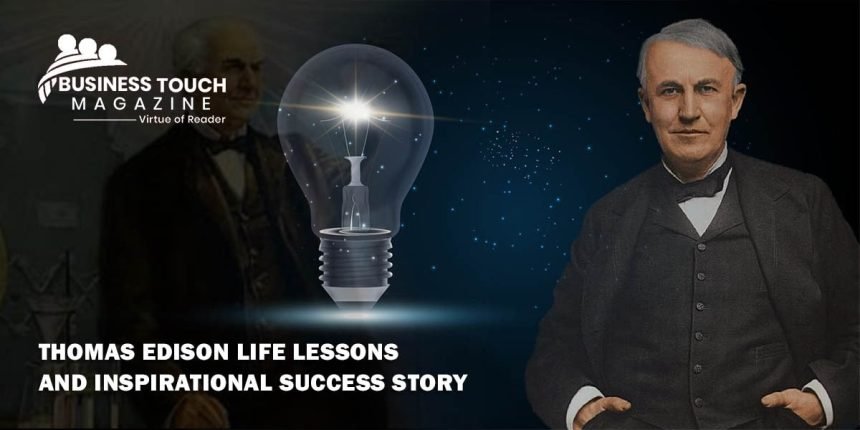Life of Thomas Alva Edison
Thomas Alva Edison, one of the most well-known and prolific inventors in history, had a profound impact on the development of modern society through his innovations, which included the incandescent light bulb, the phonograph, the motion picture camera, and advancements in the telegraph and telephone. He amassed an incredible 1,093 patents in his 84 years on this planet. Edison was not just an innovator, but also a great producer and businessman who sold his creations to consumers. Edison’s life was consumed by the many commercial relationships, partnerships, and businesses he formed, as well as the ongoing patent and corporate litigation that accompanied them. What follows is only a glimpse into a life that is very busy and complicated, full of initiatives that frequently run in parallel. Anyone interested in reading more about the specifics of his life and several business endeavours may find several great biographies on him in their local library..
Edison’s Early Years
Thomas A. Edison’s ancestors originally were from New Jersey, but they were forced to relocate to Nova Scotia, Canada because of their allegiance to the British monarchy during the American Revolution. Subsequent generations left for Ontario, where they participated in the War of 1812 against the United States. Nancy Elliott, Edison’s mother, was born in New York and raised there before moving to Vienna, Canada with her family and meeting and marrying Edison’s father, Sam Edison, Jr. Sam and his family moved to Milan, Ohio, in 1839 after he was exiled to the United States after his participation in a failed revolt in Ontario in the 1830s.
On February 11, 1847, Thomas Alva Edison was born to Sam and Nancy Edison in Milan, Ohio. Edison, who went by “Al” as a kid, was one of seven kids, four of whom made it to maturity. In his youth, Edison often suffered from bad health.
In 1854, Sam Edison uprooted his family and went to work in the logging industry in Port Huron, Michigan, in the hopes of improving their financial situation.
Academically, Edison did quite poorly. Teachers dubbed Edison “addled,” and his mother pulled him out of school to educate him herself. Long after the fact, Edison said “My mom shaped me into who I am today. Because she was honest and confident in me, I knew I had someone to live for and that I could not let her down.” 1 Even as a young child, he shown an interest in machines and chemistry.
Edison began working as a newspaper vendor and candy salesman on the Grand Trunk Railroad to Detroit in 1859. To conduct his chemical experiments and launch the Grand Trunk Herald, the first newspaper ever printed on a train, he converted a compartment in the luggage car into a makeshift laboratory and printing machine. He had to abandon his on-board studies due to an unexpected fire.
Edison began having significant hearing loss at the age of twelve. One of the possible explanations for his deafness. Some believe that it’s due to scarlet fever’s long-lasting symptoms, which he suffered from as a kid. Although Edison denied ever starting the fire in the baggage car, some insist it was because the conductor had boxed in his ears in retaliation for the event. Even Edison himself put the blame on being hoisted by his ears and carried to a train. However, he did not let his impairment stop him, and in fact, he sometimes saw it as an advantage since it allowed him to focus more easily on his experiments and studies. But there’s no denying that being deaf made him more introverted and distant from others.
Edison’s Later Years
Thomas A. Edison, Inc. was formed in 1911 from the consolidation of Edison’s previous business ventures. Edison’s involvement in day-to-day operations diminished as the company became more diverse and organised, although he retained some decision-making power. The company shifted its focus from constant innovation to ensuring its continued commercial sustainability.
In 1914, a fire swept across the West Orange laboratory, destroying 13 out of the total 16. Despite the substantial damage, Edison led the effort to reconstruct the site.
When Europe entered World War I, Edison urged the continent to be ready, believing that technological warfare was the wave of the future. In 1915, he was put in charge of the government’s effort to incorporate science into the military by establishing the Naval Consulting Board. Some of Edison’s ideas were ignored, but the board was nonetheless helpful in establishing a laboratory for the Navy that opened in 1923. However, Edison thought that the navy was not receptive to many of his innovations and proposals during the war, despite the fact that he devoted most of his time to naval research (especially submarine detection).
As his health deteriorated in the 1920s, Edison spent more time at home with his wife. Despite Charles’ success as president of Thomas A. Edison, Inc., he struggled to maintain close relationships with his children. Edison continued to experiment at home, but he was unable to conduct all of the tests he had hoped to in his West Orange lab because the board had not given its approval. The quest for a rubber substitute was one of the projects that particularly piqued his interest at the time.
In 1929, on the 50th anniversary of Edison’s electric light, Henry Ford, an admirer and friend of Edison’s, recreated Edison’s innovation factory as a museum at Greenfield Village, Michigan. In Dearborn, Ford and GE staged the primary event for Light’s Golden Jubilee, which included a gala supper in Edison’s honour attended by luminaries including President Hoover, John D. Rockefeller, Jr., George Eastman, Marie Curie, and Orville Wright. However, Edison’s health had deteriorated to the point that he was unable to remain for the whole of the event.
His health steadily deteriorated during the course of his last two years, and he eventually slipped into a coma on October 14, 1931. On October 18, 1931, he passed away at his West Orange, New Jersey mansion Glenmont.




